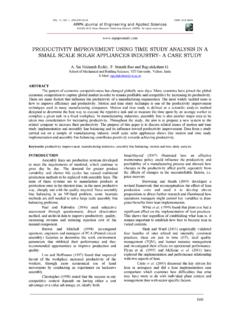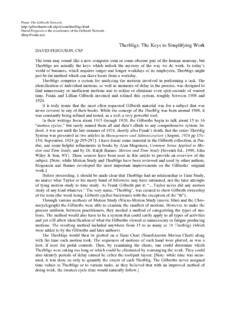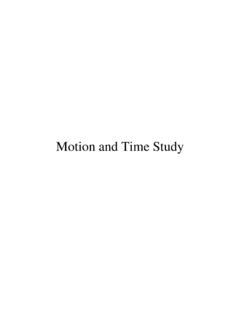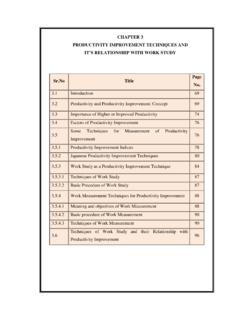Transcription of Copyright Warning & Restrictions
1 Copyright Warning & Restrictions The Copyright law of the United States (Title 17, United States Code) governs the making of photocopies or other reproductions of copyrighted material. Under certain conditions specified in the law, libraries and archives are authorized to furnish a photocopy or other reproduction. One of these specified conditions is that the photocopy or reproduction is not to be used for any purpose other than private study , scholarship, or research.. If a, user makes a request for, or later uses, a photocopy or reproduction for purposes in excess of fair use that user may be liable for Copyright infringement, This institution reserves the right to refuse to accept a copying order if, in its judgment, fulfillment of the order would involve violation of Copyright law. Please Note: The author retains the Copyright while the New Jersey Institute of Technology reserves the right to distribute this thesis or dissertation Printing note: If you do not wish to print this page, then select Pages from: first page # to: last page # on the print dialog screen The Van Houten library has removed some of the personal information and all signatures from the approval page and biographical sketches of theses and dissertations in order to protect the identity of NJIT graduates and faculty.
2 AN ANALYSIS OF PREDETERMINED time SYSTEMS. BY. RICHARD 0. SCHMID. A THESIS. SUBMITTED TO THE FACULTY OF. THE DEPARTMENT OF MANAGEMENT ENGINEERING. OF. NEWARK COLLEGE OF ENGINEERING. IN PARTIAL FULFILLMENT OF THE. REQUIREMENTS FOR THE DEGREE. OF. MASTER OF SCIENCE WITH A MAJOR. IN MANAGEMENT ENGINEERING. NEWARK, NEW JERSEY. 1957. ABSTRACT. This paper endeavors to compare three predetermined time systems, namely; Work-Factor, Methods- time Measure- ment and Basic motion Timestudy, elemental-by-elemental, through the use of a series of detailed analyses. The following information in the form of conclusions and recommendations has been set forth from the investigation of the various comparative analyses contained herein: I. Reasons for the variation between the elementals. 2. A chronological order of attack for further study with an eye to accomplishing the most in the shortest possible time . 3. The results of a composite analysis which utilizes the most realistic elemental definitions of the three systems.
3 (This includes the comparison of the latter and the other three systems of predetermined time standards to the time study values for the operation being analyzed). 4. An indication of which systems appear to be the quickest and easiest to use, based on the operation that was analyzed. 5. Recommendations concerning the selection i i of a predetermined time system for actual use. In addition, the introductory chapters acquaint the reader generally with the time study Technique and the history and operation of all of the well known systems of predetermined time standards. iii APPROVAL OF THESIS. FOR. DEPARTMENT OF MANAGEMENT ENGINEERING. NEWARK COLLEGE OF ENGINEERING. BY. FACULTY COMMITTEE. APPROVED: NEWARK, NEW JERSEY. JUNE, 1957. iv PREFACE. The purpose of this paper is essentially to compare three well known predetermined time systems, elemental by elemental, in order to find out how and why they differ, if at all, and also to determine which of the systems is the easiest and quickest to use based on the operation that was analyzed.
4 Originally it was planned to analyze a hand operation and a man-machine operation. However, it was soon realized that either one or the other was sufficient for the purposes of this paper, since the fundamental motions are designated as universal and hence found in either operation. Analysis of both would simply have amounted to duplication. Actually it did not matter which type of operation was chosen for analysis, as long as the one selected "ran the gamut" of the fundamental motions as presented by the predetermined time systems. In short, coverage of elementals was essential. As the work progressed, it became apparent that it would be advantageous to analyze the industrial operation that was selected, not only by the three standard pre- determined time systems, but also by a "composite system". which utilized the most realistic fundamental motion definitions of each of those systems. This, of course, was done with the purpose of comparing all four values to the time study value for the operation to ascertain which system(s) compared most favorably to time study .
5 Of course, the results of this phase of the analysis cannot be as detailed nor as accurate as those described in the first paragraph. This type of analysis done properly would involve the use of many time studies of various types of operations (a representative sample) with their respective predetermined time system or "composite system". analyses in order to statistically determine whether or not a significant difference exists. Although this paper considers only one operation, it appears to be a step in the right direction and definite trends can be determined. Chapter I acquaints the reader with the two basic techniques for determining the standard time of an operation - time study and the Predetermined time Systems, through a discussion of the basic concepts and individual histories of each. Chapter II familiarizes the reader with the princi- ples of operation of each predetermined time system as discussed in Chapter I, so that he might proceed to the rest of the text and follow the various detailed analyses contained therein.
6 Chapter III sets forth the actual element analyses of a selected industrial operation through the use of vi each of three specific predetermined time systems. These are Work-Factor, Methods- time Measurement and Basic motion Timestudy. This is preceded by a detailed description of the operation. Chapter IV has as its purpose the presentation of the various detailed breakdowns of the latter analysis in the form of the charts, tables and discussions that are necessary to fulfill the purposes of the thesis as stated. Finally, Chapter V presents the conclusions derived from a searching analysis of the results of Chapter IV, and as well sets forth some recommendations based primarily on those conclusions. It is strongly suggested that the reader read each chapter and especially the introduction to Chapter IV. before attempting to study any of the analysis charts or discussions as presented in Chapter IV. I would like to express sincere appreciation for the many helpful suggestions and criticisms given me by Professor Oliver J.
7 Sizelove of Newark College of Engineering. Also, grateful acknowledgment is made to Mr. James H. Duncan, Managing Partner of the Work-Factor Company for sending me a copy of The Detailed Work-Factor Manual; to Messrs. Gilbert P. Blackwood and David Egan, vii also of the latter Company, who were kind enough to review the technical details of the Work-Factor analysis contained herein; to Harold B. Maynard, President of the Methods Engineering Council who forwarded to me much useful information concerning the application of Methods- time Measurement; and to my typist Miss Joan M. Schmid who spent many tedious hours at the keyboard. Finally, permission to quote is gratefully acknowledged as secured from the following publishers: The Chilton Company, Inc. Harper and Brothers Publishers John Wiley and Sons, Inc. The McGraw-Hill Book Company, Inc. The McGraw-Hill Publishing Company, Inc. Magazines of Industry, Inc. Prentice-Hall, Inc. The Ronald Press Company Society for the Advancement of Management Richard 0.
8 Schmid Union, New Jersey June, 1957. viii TABLE OF CONTENTS. Title Page Abstract ii Approval Page iv Preface Table of Contents ix List of Figures xiii List of Tables xiv CHAPTER I: INTRODUCTION TO STOPWATCH time study AND. THE PREDETERMINED time SYSTEMS. Background of Stopwatch study 1. time study - The Definition I. History of time study 2. Predetermined time Systems 6. The Definition and Basic 6. History of Predetermined time Systems 9. The Uses of Predetermined time Systems 1. Developing Effective Methods in Advance of Production a 1. Improving Existing Methods 2. Establishing time Standards 2. Developing Standard Data and time Formulas 3. Estimating 4. Guiding Product Design 4. Developing Effective Tool Designs 4. Selecting Effective Equipment 5. Training Supervisors to Become Methods-Conscious 5. Settling Grievances 5. Operator Training 6. Research 6. Advantages, Disadvantages and Limitations of Predetermined time Systems. 6. Advantages of Predetermined time Systems 6.
9 Disadvantages and Limitations of Predetermined time Systems 8. Summary of a Survey which Determines What 132 Users Are Really Getting From PTS 9. ix Historical Background of the Development of the Individual Predetermined time Systems 21. History of motion time Analysis (MTA) 21. History of Work-Factor 22. History of Methods- time Measurement (MTM).. 24. History of Dimensional motion Times (DMT). 28. History of Basic motion Timestudy (BMT) 29. Summary 30. CHAPTER I I : THE OPERATION OF THE PREDETERMINED. time SYSTEMS. Introduction 30. Operation of motion time Analysis (MTA) 32. Definition and Theory of MTA 32. The MTA Basic Motions 34. The Application of MTA 36. Operation of Work-Factor 38. Definition and Theory of Work-Factor 38. The Application of Work-Factors 41. Standard Elements of Work 46. Effect of Simultaneous Elements on time . 47. Scope and Use of the Work-Factor System 47. Making the Work-Factor Analysis 48. Operation of Methods- time Measurement (MTM) 49.
10 Definition and Theory of MTM 49. The MTM Basic Motions 49. Limiting Motions 55. Simplified Data 56. MTM Application Procedure 56. Why is MTM Different?.. 57. Operation of Dimensional motion Times (DMT) 58. Definition and Theory of DMT 58. Scope of Application 59. The DMT Basic Motions 60. The Application of DMT 64. Operation of Basic motion Timestudy (BMT) .65. Definition and Theory of BMT 65. The BMT Basic Motions 66. The Application of BMT 72. Summary 72. CHAPTER III: THE ANALYSIS OF A SELECTED INDUSTRIAL. OPERATION USING THE PREDETERMINED. time SYSTEMS. Selection of the Predetermined time Systems to be Used in the Analysis of the Operation, "Make Cartons" 74. The Nature of the Elemental Analysis 76. Shoe We Operation - Operational Description 77. Element Descriptions of Sub-Operation 1., "Make Cartons" 79. Work-Factor Element Analysis of "Make Cartons" 86. Element I: Pick Up Carton 86. Element 2: Open Carton and Fold Ends 87. Element 3: Place Carton on Stapler 89.










